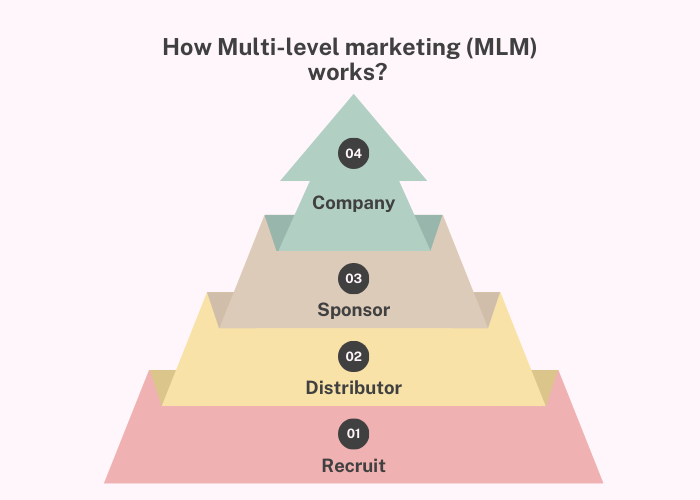Multi-level Marketing, often called MLM, is a sales strategy emphasizing selling products and recruitment. In an MLM strategy, salespeople are incentivized to sell inventory and expand the sales network by onboarding additional salespeople.
This dual focus means that as a salesperson in an MLM setup, you’re rewarded for your direct sales and indirectly for the sales made by the people you recruit. This structure tends to benefit those at the top levels of the sales network, who have many recruits under them.
Table of Contents
What Is Multi-Level Marketing (MLM)?
Multi-level marketing is a marketing strategy in which a direct sales company compensates its salespeople for the sales they generate and the sales of other people they recruit. This recruited sales force is called a participant or downline and can provide multiple compensation levels.
The structure of MLM companies varies widely. Some have a single level of compensation, while others have various levels. The most common is the pyramid-shaped MLM company. In these companies, participants at the top of the pyramid recruit others to join the program. When someone new joins the program, they start at the bottom of the pyramid.
Multilevel marketing, also called network marketing, sells products or services through a network of distributors. The distributors are called participants, and they earn income from the sales they make and from the sales made by the people they recruit to join the network, called their downline.
Multilevel marketing, also called network marketing or pyramid selling, is a type of sales where companies make money from a non-salaried workforce that sells their products or services. The participants’ earnings come from a commission system shaped like a pyramid or binary structure.
The people who recruited them then received a commission on their sales. This process continues until someone reaches the top of the pyramid, stopping recruiting new people and instead earning a percentage of all sales made by participants below them.
Key Takeaways
- Multilevel marketing is a type of sales where direct sales companies make money from a non-salaried workforce that sells their products or services.
- MLM’s business model is also called network marketing or pyramid selling.
- The participants’ earnings come from a commission system shaped like a pyramid or binary structure.
- Multilevel marketing companies vary widely in terms of their structure. Some have a single level of compensation, while others have multiple levels.
- The pyramid-shaped MLM enterprise is the most typical form of Multilevel marketing business.
Meaning of Multilevel Marketing
Many businesses rely mainly on sales to generate revenue, and one legitimate way to do this is through multilevel marketing.
Usually, in multilevel marketing programs, participants can receive compensation from two different revenue streams. A seller could receive two types of commissions: selling the product or service and getting other people to sell it. The commission received is based on either their sales or the wholesale purchases made by those they recruited.
Downline distributors are those recruited by the original participants and anyone else they recruit. This refers to the organizational hierarchy in MLM businesses.
Expanding upon the preceding discussion, it’s not uncommon for MLM salespeople to sell products directly to end-user retail clients using relationship referrals and word-of-mouth marketing. However, they are rewarded for bringing others as fellow salespeople and empowering the company’s distribution chain. This makes them the downline distributors in the organizational structure of Multilevel marketing businesses.
The Federal Trade Commission website published a report that analyzed the business models of 350 MLM companies in America. The study found that at least 99% of people who join an MLM company will lose money.
However, MLM companies continue to operate under the guise that participants can achieve large returns, even though this is statistically improbable. Because MLM businesses are simply variations of conventional pyramid schemes, several jurisdictions have outlawed or tightly controlled them.
How does Multilevel Marketing Company work?
The workings of MLM depend on the structure of the enterprise. The participants or distributors sell products or services door-to-door or through a catalog. They earn a commission on their sales and the sales of other downline members, typically through a hierarchy of levels.
The participants are usually expected to recruit more people to join the scheme to earn more commissions. The people at the top of the hierarchy usually make the most money, while those at the bottom make less.
Multilevel marketing is a controversial business model. Some call it a legal pyramid scheme, while others assert it is a legitimate way to sell products and services. Companies using this business model must be very careful to avoid being accused of illegally operating pyramid schemes.
How do you know if the Multilevel Marketing Scheme is targeting you?
Recognizing a multilevel marketing opportunity can often be challenging due to the legitimate veneer these companies usually present. However, certain characteristics and common patterns can help you identify if an MLM scheme is targeting you. Although not all MLMs are inherently negative, awareness of these signs can help you make an informed decision.
- Recruitment Emphasis: If the company seems more focused on recruiting new members than selling products, it could indicate an MLM scheme.
- Investment Requirement: They ask you to invest a significant amount upfront to become a ‘distributor’ or ‘partner.’
- Purchase Requirements: MLMs often require their members to purchase and maintain an inventory of the company’s products.
- Promises of High Returns: Be wary if the company promises high returns or depicts a luxury lifestyle due to joining the venture.
- Pressure Tactics: MLMs often use high-pressure tactics to encourage quick decision-making.
- Complicated Compensation Structure: A complicated or unclear payment or commission structure is often a red flag.
The best way to protect yourself from falling victim to an MLM scheme is to thoroughly research the company before signing up. Ask questions about their product, commission structure, and recruiting methodology. This will help you understand what the company offers and whether it aligns with your goals.
Is MLM Legal?
The multilevel marketing business model is controversial. Some call it a legal pyramid scheme, while others assert it is a legitimate way to sell products and services. The legality of MLM depends on the structure of the enterprise.
In general, network marketing or multilevel marketing refers to a type of sales approach in which individuals in a firm are incentivized to recruit new people into the business. Once recruited, the salesperson gets a percentage of the recruiter’s profits.
Furthermore, each salesperson earns a commission from the sale of products. Hence, multilevel marketing businesses are generally legal business models that recruit distributors who earn money by selling products to other members that they recruit and through commissions earned on these sales.
Is MLM a Pyramid Scheme?
Pyramid schemes are illegal in many jurisdictions because they are believed to harm consumers and can be a form of financial fraud. On the other hand, many people see multi-level marketing businesses as legitimate business models. Multilevel marketing businesses also have a different organizational structure than pyramid schemes, typically hierarchical, with a single person at the top.
MLM businesses, on the other hand, have a flatter structure in which participants are more equal. They also typically sell actual products or services, while pyramid schemes often do not. One common argument against calling MLM a pyramid scheme is that not all participants lose money in MLM.
While it is true that some people do make a profit from these businesses, the vast majority of people do not. The majority of people who get involved in MLM end up losing money. So, MLM is not a pyramidal scheme but can become pyramidal if it’s not managed correctly.
Pros and Cons of Multilevel Marketing
Pros of Multilevel Marketing:
- Multilevel marketing opens the door to a broader customer base: It enables businesses to connect with a wide customer base across various geographical regions.
- Cost-effective strategy: MLM enables businesses to function more economically by eliminating traditional retail or advertising costs and lowering fixed-wage expenses.
- Entrepreneurial flexibility: MLM enables individual participants to make income according to their schedule and personal obligations.
Cons of Multilevel Marketing:
- Income disparity: Because of the hierarchical nature of commission distribution, lower-tier players earn substantially less despite putting forth tremendous work.
- Limited support: Because of the autonomy granted to MLM participants, they frequently lack adequate training or support from the firm, which might impede their sales productivity.
- Risk to reputation: Independent distributors’ unethical behavior might affect the company’s brand and customer trust.
- MLM’s similarities to pyramid schemes can cause mistrust, legal investigation, and financial hardship for participants.
What is the difference between multilevel marketing and a pyramid scheme?
The main difference between a pyramid scheme and a Multi-level marketing business is that MLM business participants sell products or services. In contrast, participants in pyramid schemes only receive commissions for recruiting new people.
MLM businesses also typically have a flatter organizational structure than pyramid schemes, which are typically hierarchical, with a single person at the top. Multi-level marketing businesses also tend to be more transparent about how profits are divided among participants than illegal pyramid scheme-based businesses.
When MLMs Fail?
MLMs struggle when recruiting stagnates since they rely on ongoing expansion to generate money. Failures in MLM organizations are frequently caused by growing unhappiness among suppliers or distributors over unethical practices, comparable to the difficulties in the LuLaRoe debacle. Regardless of the corporation’s existence, individual distributors may suffer difficulties inside an MLM long before its demise.
Using new examples, suppliers sued LuLaRoe over invoice payment irregularities, and the company is now facing a class-action lawsuit from clients who got defective goods. Concurrently, the firm settled a complaint from Washington State accusing them of running an illegal pyramid scheme.
Examples of Multi-level Marketing Companies
1. Tupperware Brands Corporation
Tupperware is famous for its plastic containers and kitchenware products. Founded in 1948, the company sells its products through a direct sales force of independent representatives, often through parties and demonstrations.
Tupperware’s sales model incorporates elements of multi-level marketing, with representatives earning income from sales and recruiting new representatives.
2. doTERRA
doTERRA, founded in 2008, specializes in essential oils and related goods. It follows an MLM model, with independent distributors known as “Wellness Advocates” selling items directly to consumers and recruiting new distributors while receiving commissions and bonuses based on the profitability of their sales network.
3. Young Living
Young Living, like doTERRA, is a renowned essential oils market firm that was formed in 1993. It also employs an MLM structure, encouraging its distributors to sell products and recruit new members to grow its downline, which allows them to earn additional commissions and bonuses.
4. Scentsy
Scentsy was founded in 2004 and distributes scented products such as wax warmers, vehicle bars, and laundry care items. Its business concept is built on multi-level marketing (MLM), in which consultants sell products directly to consumers and can earn extra money by recruiting other consultants.
5. Pampered Chef
Pampered Chef, founded in 1980, sells high-quality cooking tools, cookware, and culinary products. The company has a direct sales model, with consultants organizing cooking events and demonstrations to market products. Consultants receive a percentage on sales and can also make money by inviting others to join.
Top MLM Companies in 2024
As we look towards the future, let’s briefly overview the top contenders in the Multi-Level Marketing (MLM) landscape for 2024. These organizations are poised to redefine the industry with their innovative business models, extensive product lines, and expansive networks of dedicated distributors.
- Amway ($8.8 billion)
- Avon ($5.7 billion)
- Herbalife ($4.5 billion)
- Vorwerk ($4.2 billion)
- Mary Kay ($3.25 billion)
- Tupperware ($2.21 billion)
- Natura ($2.26 billion)
- Oriflame ($1.4 billion)
- Ambit Energy ++ ($1.2 billion)
- Sun Hope ($940 million)
Conclusion!
Multi-level marketing has existed for many years, and legitimate businesses and scams exist. Be sure to research before getting involved with any multi-level marketing opportunity, and always remember that you should never have to pay to start your own business!
If you’re interested in multi-level marketing, look for independent business owners who are already successful with the company’s product and ask them how to get started.
Do you have any experience with multi-level marketing? Share your story in the comments below!
Liked this post? Check out the complete series on Marketing





thanks a lot dear . i am also a student of marketing and now a day i am also trying to spread marketing knowledge
Hello Mr.Hitesh Bhasin I really like the article about multi level marketing it is very informative with wonderfull examples thank you
really like your article. keep updating your blog with juice marketing topics.
I your article keep updating your blog with joice marketing topics